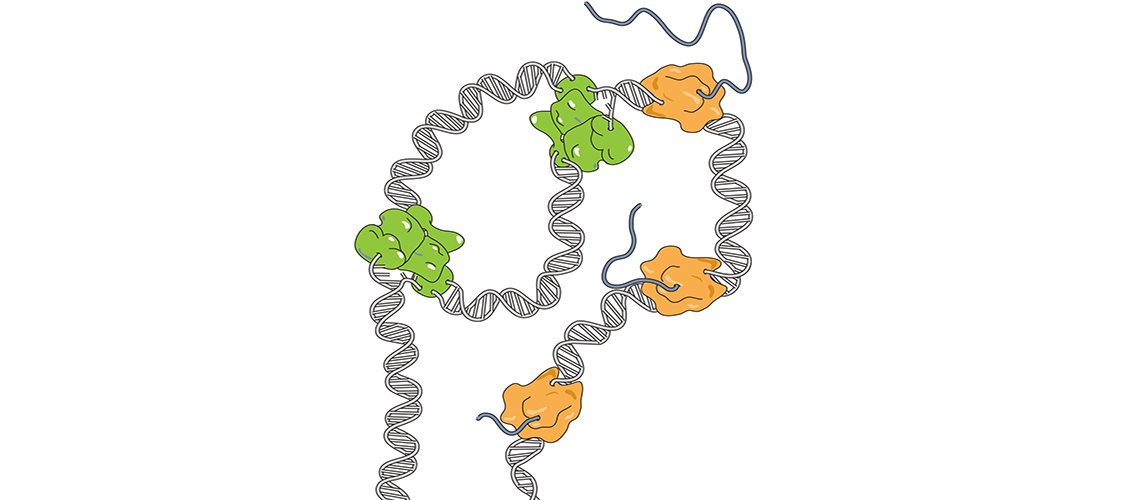Reducing the side effects of breast and ovarian cancer treatment
By showing how a type of anticancer drug kills cancer cells and damages healthy cells, a UNIGE team is paving the way for improved treatments.

The image shows collisions of the replication and transcription machineries on DNA. These collisions are prevented by the PARP1 enzyme, whose inhibition is exploited for treatment of select breast and ovarian cancers. © Nicolas Roggli and Thanos Halazonetis
Some anti-cancer treatments not only target tumour cells but also healthy cells. If their effects on the latter are too strong, their use can become limiting. A team from the University of Geneva (UNIGE), in collaboration with Basel-based FoRx Therapeutics, has identified the mechanism of action of PARP inhibitors, used in particular for breast and ovarian cancer in patients carrying the BRCA gene mutation. These inhibitors block two specific activities of the PARP proteins. By blocking one of them, the toxic effect on cancer cells is maintained, while healthy cells are preserved. This work, published in the journal Nature, will help improve the efficacy of these treatments.
Despite the thousands of lesions that damage our DNA every day, the genome of our cells is particularly stable thanks to a highly efficient repair system. Among the genes coding for repair proteins are BRCA1 and BRCA2 (for BReast CAncer 1 and 2), which are particularly involved in DNA double helix breaks. The presence of mutations in these genes (in around 2 out of every 1,000 women) can result in non-repair of damaged DNA, and greatly increase the risk of developing breast or ovarian cancer (or prostate cancer in men).
"THE MECHANISMS BY WHICH ANTI-PARPS KILL CANCEROUS AND HEALTHY CELLS ARE STILL POORLY UNDERSTOOD".
Michalis Petropoulos, post-doctoral researcher at the UNIGE
PARP inhibitors have been used to treat this type of cancer for around 15 years. PARP proteins can detect breaks or abnormal structures in the DNA double helix. PARPs then temporarily stick to the DNA, synthesizing a chain of sugars which acts as an alarm signal to recruit the proteins involved in DNA repair. Treatments based on PARP inhibitors block these activities and trap the PARP protein on the DNA. There is then no alarm signal to trigger DNA repair.
This treatment proves toxic for fast-growing cells such as cancer cells, which generate too many mutations without having time to repair them and are thus doomed to die. But our bodies are also home to fast-growing healthy cells. This is the case, for example, of hematopoietic cells - the source of red and white blood cells - which, as collateral victims, are also massively destroyed by anti-PARP treatments.

The mechanisms by which anti-PARP drugs kill cells (cancerous or not) are still poorly understood. Professor Thanos Halazonetis’ laboratory in the Department of Molecular and Cellular Biology at the UNIGE Faculty of Science, in collaboration with FoRx Therapeutics, has dissected the mechanisms of action of PARP inhibitors. The scientists used two classes of PARP inhibitors that identically block PARP’s enzymatic activity – that is, the synthesis of the sugar chain that serves as an alarm signal - but do not trap PARP on DNA with the same strength. The team observed that both inhibitors kill cancer cells with the same efficiency, but that the inhibitor that weakly binds PARP to DNA is much less toxic to healthy cells.
"THIS KNOWLEDGE WILL ENABLE US TO DEVELOP
SAFER TREATMENTS.
Thanos Halazonetis, full professor, UNIGE
‘‘We discovered that PARP not only acts as an alarm signal to recruit DNA repair proteins, it also intervenes when abnormal DNA structures are formed as a result of collisions between different machineries that read or copy the same portion of DNA,’’ explains Michalis Petropoulos, post-doctoral fellow in the Department of Molecular and Cellular Biology at the UNIGE Faculty of Science and first author of the study.
When using anti-PARP treatment, this warning signal to prevent collisions is not triggered. These collisions between the machinery will lead to an increase in DNA lesions, which cannot be repaired in cancer cells, because they lack the BRCA repair proteins. The second activity of PARP treatments, resulting in tight binding, aka trapping, of PARPs on DNA also leads to DNA damage that needs to be repaired by cells. But this repair is not mediated by the BRCA repair proteins and, as a result, both normal and cancer cells are killed.
‘‘We therefore discovered that inhibition of the enzyme activity is sufficient to kill cancer cells, whereas trapping - when PARP is strongly bound to DNA - kills the normal cells as well, and therefore is responsible for the toxicity of these drugs,’’ summarizes Thanos Halazonetis, head of the study. ‘‘This knowledge will make it possible to develop safer PARP inhibitors that inhibit PARP’s enzymatic activity without trapping it on DNA’’.
